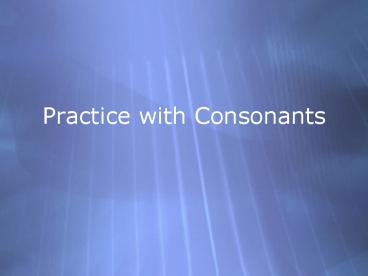Practice with Consonants - PowerPoint PPT Presentation
1 / 17
Title: Practice with Consonants
1
Practice with Consonants
2
The Vowels of English
- Vowels differ from consonants in that there is no
obstruction of the airstream in the vocal tract. - Unfortunately, as a result of this, the
distinctive features of vowels are not as easy to
see, feel or hear as those of consonants.
3
Describing Vowels
- We use four criteria to distinguish vowels
- Tongue height
- Frontness
- Tenseness
- Lip rounding
4
Tongue Height
- Tongue height describes how high in the mouth the
tongue is when the vowel is pronounced. - Compare the position of your jaw when you say
meet /mit/ and mat /m?t/. Your jaw drops to
accommodate your tongue, which rises and falls
depending on the vowels you produce. - Vowels like /i/ are called high vowels, vowels
like /?/ are called low vowels, and those in
between are called mid vowels.
5
Some English Vowels by Height
6
Frontness, or Advancement
- Frontness describes the tongues position with
respect to the front or the back of the mouth. - Compare the position of your tongue when you say
keep /kip/ and coop /kup/. You might be able to
notice that your tongue is farther forward when
you produce the /i/ vowel, and farther back when
you produce /u/. - Vowels like /i/ are called front vowels, while
vowels like /u/ are called back vowels. Those
produced centrally are called, predictably,
central vowels.
7
Some English Vowels by Tongue Height and Frontness
- These vowels are the same in many dialects of
American English.
8
Tenseness
- Tense vowels and lax vowels are distinguished by
the amount of muscle tension in the vocal tract
when they are produced. - Compare /i/ in meet /mit/ and /?/ in mit /m?t/.
The muscles in your throat tense up in the first
word and relax in the second.
9
Roundedness
- The final feature we use to describe vowels is
roundedness simply, the lips are rounded in the
production of rounded vowels (such as the /u/ in
who) and unrounded in the production of unrounded
vowels (such as the /i/ in whee!).
10
So!
- Every vowel in English can be described using
these four categories. - /i/ is a high, front, tense vowel.
- /?/ is a mid, back, lax, rounded vowel.
- Again, the vowels are physically organized in the
IPA chart to reflect these criteria
11
The Vowels of American English
12
Vowel Mergers in American EnglishSomething that
might make this difficult.
13
Vowel Mergers in American English
- The a? merger
- This merger is occurring quite rapidly, all
across the country, moving generally South to
North. - It results in pairs of words like cot / caught
and don / dawn sounding the same. - The ?? merger
- This merger is occurring largely in Appalachia,
especially Kentucky and parts of southern Ohio. - It results in pairs of words like pin / pen and
tin / ten sounding the same.
14
The Mid Central Vowels
- You will note that there are two mid central
vowels /?/, or schwa, and /?/, or wedge.
Both have the same sound. - /?/ represents the tendency in English of vowels
in unstressed syllables to shift to a mid central
vowel. - For example, although can is usually pronounced
with a low front vowel /c?n/, in a sentence it
usually moves to schwa I can come. sounds like
/ai k?n k?m/. - /?/ represents stressed vowels whose natural
position is mid central, as in come in the
example above.
15
Diphthongs
- A diphthong is a sequence of two sounds, a vowel
plus a glide. - The three diphthongs occurring in English are
- /aj/ as in high
- /aw/ as in cow
- /?j/ as in boy
- But note that this is a somewhat complex area
many phoneticians characterize diphthongs as two
vowels, and you may notice that the vowel /e/ we
have already learned is a near-diphthong, or
diphthongized.
16
r-coloring
- In some cases, a vowel (especially /?/)will merge
with a following /r/ sound, producing an
r-colored vowel. This is represented by
attaching the symbol ? to the vowel - farmer /fArm?/
- In practice, there is very little difference
between /fArm?/ and /fArm?r/
17
Remember
- Orientation for conversation partners is tonight
at 630 in Baker Center Ballroom!































